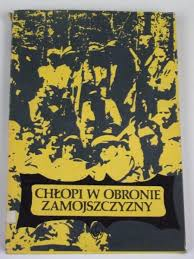Polokaust Zamosc Operation Polish Guerrilla Counteraction Gmitruk

Chlopi w Obronie Zamojszczyzny, by Janusz Gmitruk (ed.) 1985
Striking Back at the Polokaust: Polish-Guerrilla Peasant Battalions (BCh) Against the German-Nazi and OUN-UPA Genocides in the Zamosc Area
PEASANTS IN DEFENSE OF THE ZAMOSC REGION is the title of this Polish-language anthology. It combines valuable information on the Polish Underground along with the obvious taint of still Communist-ruled Poland. The latter includes such things as bad-mouthing of the prewar Polish government, questioning of the merger of the BCh (Bataliony Chlopskie) with the AK (A.K.–Armia Krajowa), glorification of the Soviet partisans and the Communist GL-AL bands, etc.
Fully 90% of not only the BCh but also the AK consisted of peasants. (Markiewicz, p. 44). By July 1944, the BCh had 40,000 guerrillas. (Marszalek, p. 92).
RESISTING THE GERMANS IN VARIOUS CREATIVE WAYS
At first, Polish peasant resistance to the Germans was passive. Poles avoided deportation by living in the fields and forests. In spite of draconian German terror, the peasants refrained from delivering the quotas of confiscated rural goods–so much so that the Germans were forced to lower the quotas. (Przysz, pp. 33-on; Rajca, p. 170). Polish peasants built elaborate hiding places for their produce, and farmers harvested crops superficially, so that most of it would remain. The German livestock-identification system was circumvented through the use of forged identification, thereby protecting some of the Polish livestock from German confiscation. Whenever possible, the worst produce was actually turned over to the Germans.
THE BCH GUERRILLA WAR AGAINST GERMAN DEPREDATIONS
BCh guerrilla combat targeted not only Volksdeutsche and German settlers, but also the German gendarmes. (Krzeszowiec, p. 166). Tens of thousands of acts of sabotage against the German administration occurred in 1942-1943. For instance, out of 600 dairy-confiscation centers in the GG (German-occupied central Poland), 150 were destroyed and 300 were seriously damaged. (Rajca, p. 173).
OPERATION ZAMOSC: GERMAN GENOCIDAL TERROR IN FULL BLOOM
The German de-Polonization effort (“Operation Zamosc”), especially during February-June 1943), was massive and brutal. 117 villages were de-populated, many Poles were murdered on the spot, countless others were locked up in transit camps under horrible living conditions, etc. (Markiewicz, p. 47-on). The BCh came out in open combat against the Germans, inflicting major casualties on them. (Krzeszowiec, pp. 165-on).
THWARTING THE UKRAINIAN GENOCIDE OF POLES
This work includes the BCh combat against the Ukrainian fascist-separatist OUN-UPA (or UIA) genocide of Poles. Already in mid-1942, one BCh unit, that of “Rysia”, had been inflicting major casualties on Ukrainian Nazi collaborators, including the Ukrainische Hilfspolizei (Hiwis) (Przysz, pp. 37-38). Some 15,000 Volhynian (Wolyn) Poles fled the 1943 UPA terror and took refuge in the Zamosc area. (Markiewicz, p. 52). The UPA genocide spread to the Zamosc area in fall 1943 (Przysz, p. 37), and the out-gunned BCh engaged in heavy combat against the UPA throughout 1944. A total of 35,000 Zamosc-area Poles were successfully evacuated westward, out of reach of the murderous UPA. (Markiewicz, pp. 52-53).
NOT JUST ON UKRAINIAN-CLAIMED TERRITORIES
We see once again that, contrary to the claims of OUN-UPA apologists, notably Ukrainians in present-day Poland who condemn Operation Wisla, there was no dichotomy between the OUN-UPA genocidal acts against Poles occurring east of the Bug and San Rivers, and that occurring west of those rivers.
To see a series of truncated reviews in a Category click on that Category:
- All reviews
- Anti-Christian Tendencies
- Anti-Polish Trends
- Censorship on Poles and Jews
- Communization of Poland
- Cultural Marxism
- German Guilt Dilution
- Holocaust Industry
- Interwar Polish-Jewish Relations
- Jewish Collaboration
- Jewish Economic Dominance
- Jews Antagonize Poland
- Jews Not Faultless
- Jews' Holocaust Dominates
- Jews' Holocaust Non-Special
- Nazi Crimes and Communist Crimes Were Equal
- Opinion-Forming Anti-Polonism
- Pogrom Mongering
- Poland in World War II
- Polish Jew-Rescue Ingratitude
- Polish Nationalism
- Polish Non-Complicity
- Polish-Ukrainian Relations
- Polokaust
- Premodern Poland
- Recent Polish-Jewish Relations
- The Decadent West
- The Jew as Other
- Understanding Nazi Germany
- Why Jews a "Problem"
- Zydokomuna